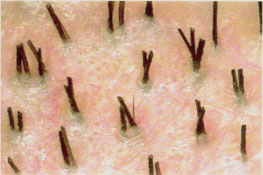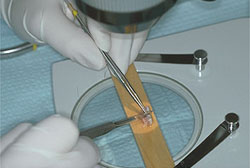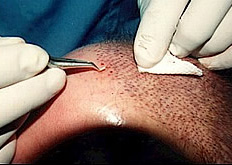INTRODUCTION
The various micrografts techniques allow an aesthetic and definitive achievement of most of all advanced stages of female androgenetic alopecia (FAGA) (Ludwig III) or male androgenetic alopecia (MAGA) (Hamilton VI-VII).
Hair micrografts or follicular unit grafts techniques are so far being proposed, namely Follicular Units Extraction (FUE) or Follicular Unit Long Hair (FUL). It has been many years since Bouhanna developed the follicular unit long hair (FUL) technique.
Combining hair transplantation and hair medical treatments (minoxidil, finasteride, cyproterone acetate, platelet rich plasma (PRP) improve the result and postoperative evolution.
MATERIALS AND METHODS
In MAGA or FAGA, hair thinning appears to follow and evolve according to a particular pattern. The Bouhanna dynamic multifactorial classification allows, for both sex, an evaluation of various parameters such as the size of bald and hairy areas, scalp laxity and thickness, hair coverage according to hair density, hair diameter, hair shape, hair length, growth rate , hair color and evaluation of advanced stages.
The surgical restoration of MAGA or FAGA consists on transplanting an adequate number of hairs (2000 to 4000 hair/session). Micrografts or follicular units (1-3 hair) are recommended.
Two techniques are currently available:
1- The follicular unit long Hair (FUL):
the scalp is not shaved previously. Long hairs are harvested with a strip followed by a special "trichophytic closure" which allows an undetectable linear scar. The implantation of 1-3 long hair graft aims at restoring a natural aspect. Long hair implanted may fall 15 days after the session and have a complete and definitive regrowth 6 to 9 months later. In that way the patient and the surgeon have with this technique an immediate preview of the result. (The "wait and see" of the conventional procedures is replaced by the "see and wait"). 5000 to 8000 hairs are transplanted in 2 sessions. Hairs are not shaved like in the conventional FUT technique but the progress is almost the same. A fine and irregular "one-by-one" frontal hair line can be expected.
2- The follicular Unit extraction (FUE):
the scalp is previously shaved. Hairs are harvested with 0,7 to 1 mm punches. FUE has in fact few indications for female baldness due to the decreased density of the donor area and for VI-VII male baldness which need the implantation of 5000 to 8000 hairs in 2 sessions. Such goal is actually impossible with the FUE. The aim of FUE is to harvest intact follicular units by hand or using power micropunch (0.7 – 1 mm). 1000 - 1500 hairs can be transplanted in one session.
DISCUSSION
The advantages of FUL are numerous. The "wait and see" is replaced by the "see and wait", the donor area is not shaved and patient scabs of the recipient are hidden by the long hair. For the surgeon, the benefits are a better evaluation of the orientation and the obliquity of transplanted hairs, a better choice for the refinements of the frontal hairline with thinner or lighter hairs.
The indications of FUE are for patients who: routinely shave their scalp, have no laxity of the scalp, are afraid of getting a fine linear scar (which can be eventually corrected with FUE in a second time), have no sign of wide baldness evolution.
CONCLUSION
The indications for wide female and male androgenetic alopecia are guided by the results of the multifactorial classification. The best choice upon each procedure will be developed according to the age (young or older patient), to the ethnic variations (Afro-americans, Asians…), to their psychological profile and their own esthetic desire.
With the FUE many sessions are necessary to get a good and dense esthetic result.
With the FUL it is possible to achieve it in one or two sessions.







